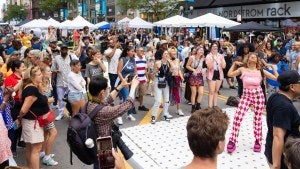How pedestrian malls are revitalizing downtowns around the world — and helping Chicago's Loop (again)

The decline of Chicago's central business corridor has made the future of downtown foot traffic and storefronts uncertain. Following models from international peers, Chicago may find that reinvesting in pedestrian malls is an effective path for urban revitalization.
As storefront vacancies reached a peak of almost 28% in 2023, according to ABC 7 Chicago, Chicago is still trying to find ways to bring businesses — and foot traffic — back to the Loop. Like other global centers, the city has experienced recent success with car-free, pedestrian malls.
The original State Street Mall
The economic ebbs and flows of Chicago’s urban center are not new. The highly fluctuating state of business on the city’s popular State Street is rooted in urbanization.
The 1970s were shaped by the tug-of-war between urban centers and developing suburbs, leading to a mass exodus from cities to sprawling suburbs.
Stephan Schmidt, associate professor of City and Regional Planning at Cornell University, has studied regional fluctuation and how pedestrian malls support urban centers.
“This was an era of white flight, massive urbanization, a lot of shopping retail, and even office work fleeing downtown cores … even what they call the malling of America and the widespread development of malls on the outskirts of metropolitan areas,” Schmidt told ChicagoGlobal.
From 1970 to 1980, Cook County’s population decreased by 4.4%, while adjacent Lake County boasted a 15.1% population boom, based on census data.
With considerable losses to the suburbs, Chicago policymakers needed ways to maintain the Loop and downtown Chicago as a viable alternative. Their most notable solution: pedestrian malls.
“It was seen as an urban renewal tool,” Schmidt said. “The idea being that they could now make or emulate the suburban shopping mall and stave off what was seen as the desolation of the downtown retail corridor.”
The State Street Pedestrian Mall appeared promising, with a nine-block, car-free zone along State Street featuring expanded sidewalks, fresh foliage, and revamped transit entrances with two lanes for bus traffic.
Unfortunately, the attempt to revitalize downtown Chicago quickly went up in smoke — literally. The bus routes that still ran through the concrete park left patrons in a perpetual smog of diesel and exhaust. Additionally, limited parking nearby made it difficult for suburbanites to explore the “new” downtown. By 1996, the pedestrian sidewalks were scaled back significantly and cars returned to the corridor.
Since the 1990s, pedestrian malls have waned considerably throughout the country. In a study from 2020, Schmidt and his colleagues at Cornell found the average lifespan of pedestrian malls was about 20 years — only 43 of the 125 pedestrian malls studied were still open when the study was published.
Nonetheless, pedestrian-dedicated zones are seeing a resurgence, with thriving models outside the United States.
How pedestrian malls work in Montreal, Dublin, and Barcelona
Successful pedestrian streets abroad provide potential models to revitalize and change Chicago’s economic trajectory. In 2019, the Chicago Loop Alliance hosted members of the Global Business Districts Innovation Club, an international collaboration between municipal business districts dedicated to the future of concentrated urban centers.
One of the most notable achievements from a member of the Innovation Club is annual pedestrian zones in Montreal. As part of a multi-year project that began during the pandemic, the city closes 10 popular streets to car traffic during the summer to become pedestrian-only zones.
- One of the city’s longest street closures, about 1.5 miles, was met with a 90% approval rating from visitors and residents.
- About two-thirds of local businesses approved of pedestrian streets.
- The project resulted in an increase between 17% and 86% in foot traffic.
Dublin’s trial pedestrianization of the bustling Grafton Street area received similar positive feedback. As a member of the Global Business Districts Innovation Club, the Dublin City Council has found ways to decrease car dependency in the city’s central business district. For six weeks over the summer in 2020, the central shopping corridor was closed to vehicular traffic on the weekends and completely open to pedestrians. The trial run resulted in 96% of people surveyed saying the street closures improved their experience, and 95% saying they were in favor of permanent pedestrianization.
The “superblocks” of Barcelona are lauded as the future of pedestrian-prioritized urban zones — the modified road network creates interior blocks of each “superblock” for pedestrians, green spaces, and limited, low-speed vehicle traffic. Studies show business performance within Barcelona’s pedestrian zones has increased by up to 30%.
'Sundays on State'
Recognizing the waning economic health of Chicago’s downtown, combined with successful international models of pedestrianization, in 2021 the Chicago Loop Alliance initiated an experiment for revitalization familiar to the central business corridor: a pedestrian mall on State Street called “Sundays on State.”
“We wanted to bring people back downtown,” said Michael Edwards, CEO of the Chicago Loop Alliance, in an interview with ChicagoGlobal. “We wanted to bring joy to people because we were all in the middle of a pandemic, and we just wanted people to experience the Loop in a different way on State Street.”

Marquee at the Chicago Theatre announcing Sundays on State

A street performance at Sundays on State

A crowded street at Sundays on State

Shoppers and vendors at Sundays on State
Sundays on State is a five-block stretch of State Street with temporary vehicular closures. The project has been hailed a success by the Chicago Loop Alliance, with notable impact:
- More than 1 million attendees have visited Sundays on State events since the program began.
- Two of the 2023 events had an economic impact of $7.8 million, including indirect and induced business sales that affected the local economy.
The popularity of Sundays on State suggests Chicago residents are ready to reinvent how they use the city’s streets.
“Streets should be thought of as a flexible space that can contribute to the economic health of the city and the street by being more than just a thoroughfare for cars,” said Edwards. “That is how we can effectively connect the street to the energy that is the city of Chicago.”
This story first appeared in the ChicagoGlobal newsletter, a joint project of Crain's Chicago Business and the Chicago Council on Global Affairs.

